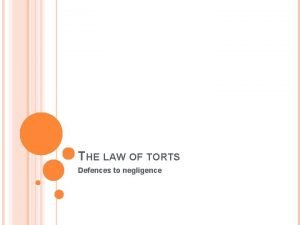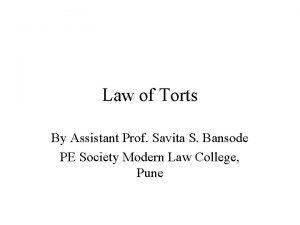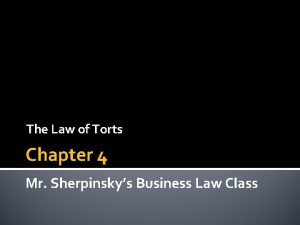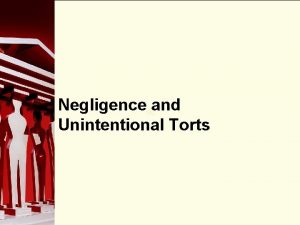THE LAW OF TORTS Defences to negligence DEFENCES








- Slides: 8

THE LAW OF TORTS Defences to negligence

DEFENCES TO NEGLIGENCE Plaintiff agreed to the risk Plaintiff contributed to damage No damage suffered No duty owed Duty wasn’t breached

PLAINTIFF AGREED TO THE RISK (volenti non fit injuria) There can be no claim to negligence where a person willingly consents to the risk that caused the injury and fully appreciates the dangers involved in the action. This is the case with many sporting injuries occurring within normal game play. Example: Agar v. Hyde; Agar v. Worsley (2000)

NO DUTY OWED A defendant relying on this defence would claim that it was not reasonable to foresee that the actions would cause the loss or damage suffered.

DUTY OF CARE WAS NOT BREACHED A duty of care is not breached if the defendant acted as any normal person would and the injury was a result of an accident or could not reasonably have been stopped or prevented. For example: at a cricket match a ball may be hit into the spectator area and possibly injure someone; it may not be feasible to fence the entire ground to avoid such a possibility.

NO DAMAGE SUFFERED The defendant claim that although they may have breached their duty of care to the plaintiff, the plaintiff suffered no damage. Alternatively, the defendant may claim that the damage or injury suffered by the plaintiff was not the result of the defendant’s breach.

PLAINTIFF CONTRIBUTED TO DAMAGE This defence is known as contributory negligence. Contributory negligence is when the person injured is in some way partly responsible for the injury. In these case the court may award a lesser payout. Example: A pedestrian who carelessly steps onto the road in front of a speeding car may sue the driver for injuries. However, the court may decide that the pedestrian was partly to blame for the incident. In Pennington V. Norris (1956) HCA 26, the High Court ruled that where a person suffers injury partly as the result of his or her own fault, the court would apportion blame and then reduce the claim for damages accordingly. Discounted damages.

NOW IT’S YOUR TURN Turn to page 200 and answer questions 3, 4 & 5 Once you have completed these, read through the handout of case studies and answer the related questions.















